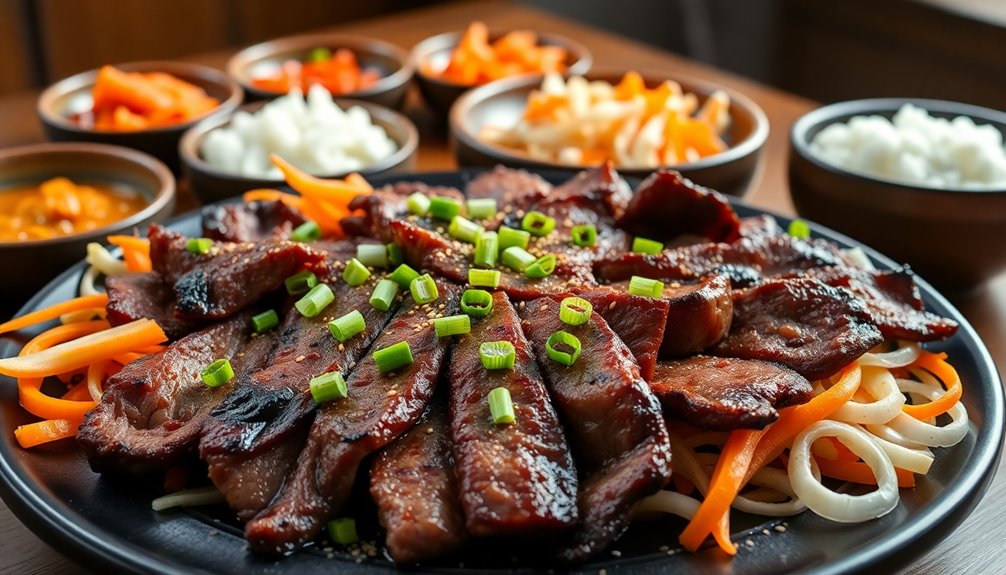To make bulgogi, start with 1 pound of thinly sliced beef, like ribeye or sirloin. For the marinade, mix 1/4 cup soy sauce, 2 tablespoons brown sugar, and 1 tablespoon sesame oil. Add minced garlic, ginger, and sliced onion for extra flavor. Marinate the beef for at least 30 minutes. Heat a grill or skillet to medium-high and sear the marinated beef for 2-3 minutes on each side. Toss in some vegetables like carrots and bell peppers, and stir-fry. Serve with steamed rice and garnishes. There's so much more to explore about this delicious dish!
Key Takeaways
- Bulgogi, meaning "fire meat," is a traditional Korean dish made from marinated and grilled beef, often served with rice.
- Marinate thinly sliced beef in a mixture of soy sauce, brown sugar, sesame oil, garlic, and ginger for at least 30 minutes.
- Cook marinated beef on a heated grill or skillet for 2-3 minutes on each side until caramelized, adding vegetables if desired.
- Serve bulgogi over steamed rice, garnished with green onions and sesame seeds, and pair with traditional banchan like kimchi.
- This dish is high in protein, low in carbs, and provides healthy fats, making it suitable for various dietary preferences.
History

Bulgogi, which translates to "fire meat," has a rich history that dates back to the Goguryeo era in Korea, around 37 BC to 668 AD.
This ancient dish originally featured marinated beef grilled over an open flame, showcasing the early Korean appreciation for bold flavors.
As you explore its evolution, you'll find that it reflects the cultural exchanges along trade routes.
By the Joseon Dynasty, bulgogi became a popular dish among the nobility, often prepared with a variety of marinades.
Today, you can see its influence across different regions, adapting to local tastes and ingredients.
Understanding bulgogi's historical roots not only deepens your appreciation of this savory dish but also connects you to Korea's rich culinary heritage.
Recipe

Bulgogi, a beloved Korean dish, is renowned for its savory-sweet flavor and tender meat. Traditionally made with marinated beef, bulgogi is grilled or stir-fried to perfection. This dish not only offers a delightful taste but also provides a wonderful opportunity to explore the rich flavors of Korean cuisine. Whether you're hosting a dinner party or simply craving something delicious, bulgogi is sure to impress.
To prepare bulgogi, the key lies in the marinade, which typically consists of soy sauce, sugar, sesame oil, garlic, and various other seasonings. The marinated beef is often served with rice and an array of side dishes, known as banchan. This recipe will guide you through the steps to make authentic bulgogi that you can enjoy any day of the week.
Ingredients:
- 1 pound of beef (ribeye or sirloin, thinly sliced)
- 1/4 cup soy sauce
- 2 tablespoons brown sugar
- 1 tablespoon sesame oil
- 4 cloves garlic (minced)
- 1 tablespoon ginger (minced)
- 1 tablespoon mirin (optional)
- 1/2 onion (thinly sliced)
- 1 carrot (julienned)
- 3 green onions (chopped)
- Sesame seeds (for garnish)
- Cooking oil (for grilling)
To cook the bulgogi, start by combining the soy sauce, brown sugar, sesame oil, minced garlic, ginger, and mirin in a bowl to create the marinade. Add the sliced beef to the marinade, ensuring it's well-coated. Let it marinate for at least 30 minutes, or ideally, a few hours in the refrigerator.
Once marinated, heat a skillet or grill over medium-high heat and add a little cooking oil. Add the marinated beef along with the onions and carrots, cooking until the beef is browned and cooked through, about 5-7 minutes. Garnish with chopped green onions and sesame seeds before serving.
When preparing bulgogi, it's important to slice the beef against the grain for maximum tenderness. If you find it challenging to slice the beef thinly, consider placing it in the freezer for about 30 minutes beforehand; this will firm it up and make slicing easier.
Additionally, feel free to customize the vegetables in your bulgogi; bell peppers or mushrooms can make great additions. Finally, serve the bulgogi hot with steamed rice and your favorite banchan for a complete meal. Enjoy!
Cooking Steps

To get started on your bulgogi, you'll first marinate the beef for about 30 minutes to infuse those delicious flavors.
Once that's done, heat up your pan and sear the beef on high heat to achieve that perfect caramelization.
After that, you'll add vegetables and stir-fry before simmering everything together for a rich, savory finish.
Step 1. Marinate Beef for 30 Minutes

Marinating the beef is an essential step that enhances its flavor and tenderness.
After slicing your beef thinly, place it in a bowl and pour your marinade over it. Make certain the marinade fully coats each piece. You can use a fork or your hands to massage the marinade into the meat for better absorption.
Cover the bowl with plastic wrap or transfer the beef to a resealable bag. Let it sit for about 30 minutes at room temperature. If you're prepping ahead, you can marinate it in the refrigerator for up to 4 hours.
Just remember to bring it back to room temperature before cooking. This short marination time will guarantee your beef is flavorful and juicy.
Step 2. Sear Beef on High Heat

Heat a large skillet or grill pan over high heat until it's sizzling hot.
Once the pan's ready, add your marinated beef in a single layer. Make sure not to overcrowd the pan; you want that perfect sear.
Let the beef cook undisturbed for about 2-3 minutes, allowing it to develop a nice crust. Flip the pieces using tongs, and sear the other side for another 2-3 minutes.
You'll know it's done when the beef is browned and cooked through, with a tender texture that melts in your mouth.
If you're cooking in batches, keep the first batch warm in a low oven while you finish the rest.
Enjoy the tantalizing aroma filling your kitchen!
Step 3. Add Vegetables and Stir-Fry

Once the beef is perfectly seared, it's time to add your choice of vegetables for a burst of flavor and color. Toss in sliced onions, bell peppers, and carrots, or any veggies you love.
Stir-fry everything together over medium-high heat, ensuring the vegetables maintain some crunch while absorbing those delicious beef juices. This shouldn't take long—just a few minutes will do.
As you stir, watch for the vibrant colors to brighten and the vegetables to soften slightly. Don't forget to taste as you go; you might want to adjust the seasoning with a splash of soy sauce or a sprinkle of sesame seeds.
Keep the heat high to achieve that perfect stir-fry texture. Enjoy the enticing aroma!
Step 4. Simmer for 10 Minutes

Now that your vegetables are stir-fried to perfection, you'll want to let everything simmer together for about 10 minutes. This step allows the flavors to meld beautifully, creating a delicious sauce that enhances your bulgogi.
Keep the heat on medium-low to maintain a gentle simmer, ensuring that nothing burns or sticks to the bottom of the pan. Stir occasionally, allowing the ingredients to blend seamlessly.
If you notice the sauce thickening too much, feel free to add a splash of water or broth to maintain the desired consistency.
After 10 minutes, you'll see how the vibrant colors of the vegetables and the tender meat come together, creating a mouthwatering dish that's ready for the next step.
Enjoy the enticing aromas wafting through your kitchen!
Step 5. Serve With Steamed Rice

To truly elevate your bulgogi experience, serving it with steamed rice is a must. The fluffy, warm rice complements the savory, marinated beef perfectly.
Start by cooking your rice according to the package instructions, whether you prefer white or brown. Once it's done, let it sit for a few minutes to firm up.
When you're ready to serve, scoop a generous portion of rice onto each plate. Then, add a heaping serving of the bulgogi on top or alongside the rice. You can also drizzle some of the flavorful sauce over the rice for extra taste.
Garnish with sliced green onions or sesame seeds for a pop of color. Enjoy this delicious combination for a satisfying meal!
Final Thoughts

As you wrap up your culinary adventure with bulgogi, remember that the joy of cooking lies not just in following the recipe but in making it your own.
Feel free to tweak the marinade ingredients to suit your taste—maybe a splash of sesame oil or an extra pinch of sugar. Experimenting with different vegetables or side dishes can elevate your meal even further.
Don't hesitate to invite friends or family to share in the experience, turning dinner into a delightful gathering. Enjoy the process, from marinating the meat to grilling it to perfection.
Each bite should reflect your personal touch. With practice, you'll master bulgogi and create lasting memories around the table.
Happy cooking, and savor every delicious moment!
Frequently Asked Questions
Can I Use Chicken Instead of Beef for Bulgogi?
Absolutely, you can use chicken instead of beef! Just make sure to thinly slice the chicken to allow it to absorb the marinade well.
While the flavor will differ slightly, the marinating process enhances the chicken's taste beautifully.
You'll want to adjust the cooking time since chicken cooks faster than beef.
What Side Dishes Pair Well With Bulgogi?
When you're planning a meal, picking the right side dishes can elevate your dining experience.
For a savory dish like bulgogi, you can't go wrong with steamed rice or a crisp green salad.
Korean pickled vegetables, known as banchan, add a tangy contrast, while kimchi brings a spicy kick.
Also, consider serving a simple cucumber salad for a revitalizing touch.
These sides complement the flavors beautifully and create a well-rounded feast.
How Long Can I Marinate Bulgogi?
You can marinate bulgogi for anywhere between 30 minutes to 24 hours.
If you're short on time, even a quick 30-minute soak can enhance the flavor.
However, letting it sit longer, around 4 to 12 hours, allows the meat to absorb the marinade more deeply, resulting in a tender and flavorful dish.
Just be cautious not to exceed 24 hours, as the meat can become too soft and lose its texture.
Is Bulgogi Gluten-Free?
When you're considering whether a dish is gluten-free, it's crucial to check the ingredients.
Traditional bulgogi often contains soy sauce, which typically has gluten. However, you can make it gluten-free by using tamari or gluten-free soy sauce.
Always read labels carefully, as some marinades might contain gluten. If you're dining out, ask the chef about their ingredients to guarantee your meal meets your dietary needs.
Enjoy your meal without worries!
Can I Freeze Leftover Bulgogi?
Yes, you can freeze leftover bulgogi! It's a great way to preserve the flavor for future meals.
Just let it cool down to room temperature, then transfer it to an airtight container or freezer bag. Make sure to remove as much air as possible before sealing it.
When you're ready to enjoy it again, thaw it in the fridge overnight and reheat gently on the stove or microwave.
Enjoy your tasty leftovers!










